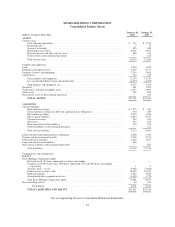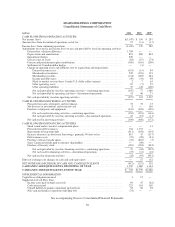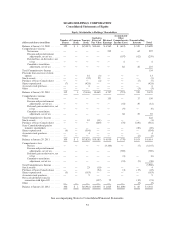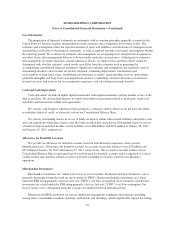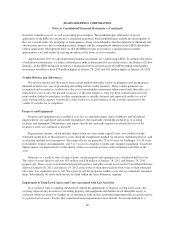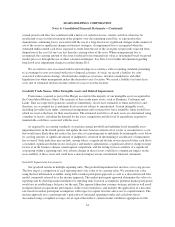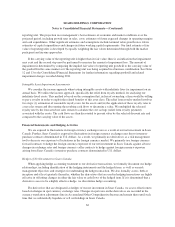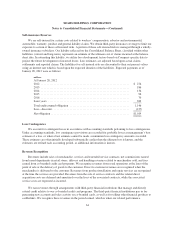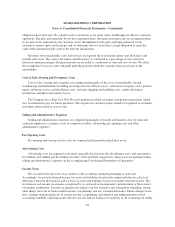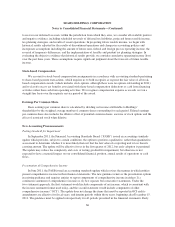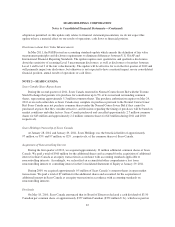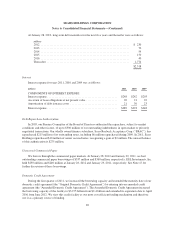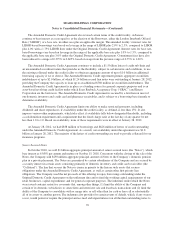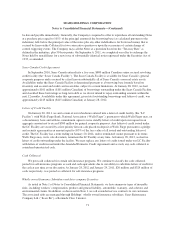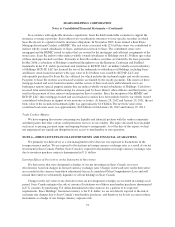Sears 2011 Annual Report Download - page 62
Download and view the complete annual report
Please find page 62 of the 2011 Sears annual report below. You can navigate through the pages in the report by either clicking on the pages listed below, or by using the keyword search tool below to find specific information within the annual report.SEARS HOLDINGS CORPORATION
Notes to Consolidated Financial Statements—(Continued)
reporting unit. The projection uses management’s best estimates of economic and market conditions over the
projected period, including growth rates in sales, costs, estimates of future expected changes in operating margins
and cash expenditures. Other significant estimates and assumptions include terminal value growth rates, future
estimates of capital expenditures and changes in future working capital requirements. Our final estimate of fair
value of reporting units is developed by equally weighting the fair values determined through both the market
participant and income approaches.
If the carrying value of the reporting unit is higher than its fair value, there is an indication that impairment
may exist and the second step must be performed to measure the amount of impairment loss. The amount of
impairment is determined by comparing the implied fair value of reporting unit goodwill to the carrying value of
the goodwill in the same manner as if the reporting unit was being acquired in a business combination. See Notes
12 and 13 to the Consolidated Financial Statements for further information regarding goodwill and related
impairment charges recorded during 2011.
Intangible Asset Impairment Assessments
We consider the income approach when testing intangible assets with indefinite lives for impairment on an
annual basis. We utilize the income approach, specifically the relief from royalty method, for analyzing our
indefinite-lived assets. This method is based on the assumption that, in lieu of ownership, a firm would be willing
to pay a royalty in order to exploit the related benefits of this asset class. The relief from royalty method involves
two steps: (i) estimation of reasonable royalty rates for the assets and (ii) the application of these royalty rates to
a net sales stream and discounting the resulting cash flows to determine a value. We multiplied the selected
royalty rate by the forecasted net sales stream to calculate the cost savings (relief from royalty payment)
associated with the assets. The cash flows are then discounted to present value by the selected discount rate and
compared to the carrying value of the assets.
Financial Instruments and Hedging Activities
We are exposed to fluctuations in foreign currency exchange rates as a result of our net investment in Sears
Canada. Further, Sears Canada is exposed to fluctuations in foreign currency exchange rates due to inventory
purchase contracts denominated in U.S. dollars. As a result, we primarily use derivatives as a risk management
tool to decrease our exposure to fluctuations in the foreign currency market. We primarily use foreign currency
forward contracts to hedge the foreign currency exposure of our net investment in Sears Canada against adverse
changes in exchange rates and foreign currency collar contracts to hedge against foreign currency exposure
arising from Sears Canada’s inventory purchase contracts denominated in U.S. dollars.
Hedges of Net Investment in Sears Canada
When applying hedge accounting treatment to our derivative transactions, we formally document our hedge
relationships, including identification of the hedging instruments and the hedged items, as well as our risk
management objectives and strategies for undertaking the hedge transaction. We also formally assess, both at
inception and at least quarterly thereafter, whether the derivatives that are used in hedging transactions are highly
effective in offsetting changes in either the fair value or cash flows of the hedged item. If it is determined that a
derivative ceases to be a highly effective hedge, we discontinue hedge accounting.
For derivatives that are designated as hedges of our net investment in Sears Canada, we assess effectiveness
based on changes in spot currency exchange rates. Changes in spot rates on the derivatives are recorded in the
currency translation adjustments line in Accumulated Other Comprehensive Income and remain there until such
time that we substantially liquidate or sell our holdings in Sears Canada.
62





